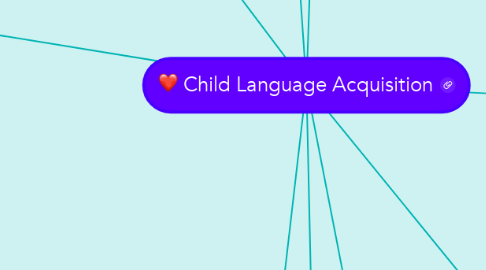
1. vocalised
2. NURTURE / BEHAVIOURISM
2.1. Skinner (1959)
2.1.1. Language is another form of learned behaviour.
2.1.2. Operant conditioning - association between behaviour and consequence.
2.1.2.1. Positive reinforcement.
2.1.2.2. Negative reinforcement.
2.1.2.3. Punishment
2.1.2.4. Similar to P.Pavlov´s salivating dogs experiment.
2.1.3. IN THE TRANSCRIPT
2.1.3.1. Imitation
2.1.3.2. Repeating
2.1.3.3. Children repairing mistakes after correction.
3. Telegraphic Stage
3.1. Around 2 years
3.2. It conveys a main message using the minimum number of words. (Key words)
3.3. Word Comprehension
3.3.1. Fast Mapping
3.3.1.1. The process of rapidly learning a new word simply from the contrastive use of a familiar and unfamiliar word
3.3.2. Likely to omit grammatical words
3.4. Making Understandable Utterances
3.4.1. ADJECTIVES
3.4.2. Begin to combine words into simple sentence
3.4.2.1. 24-30 months
3.5. Telegraphic Speech
3.5.1. development of functional categories
3.5.1.1. DETERMINERS
3.5.1.1.1. the, my
3.5.1.2. AUXILIARIES
3.5.2. Lexical categories
3.5.2.1. NOUNS
3.5.2.2. VERBS
3.5.2.3. ADVERBS
3.5.3. Missing
3.5.3.1. PREPOSITIONS
3.5.3.2. CONJUCTIONS
3.6. Lexis and Semantics
3.6.1. Agent+ Action
3.6.1.1. Mummy,come
3.6.2. Action + Object
3.6.2.1. Drive car
3.6.3. Agent + Object
3.6.3.1. Baby book
3.6.4. Action+ Location
3.6.4.1. Go park
3.6.5. Possessor and possession
3.6.5.1. My teddy
3.6.6. Entity and attribute adjective
3.6.6.1. Box shiny
4. Key Theorists
4.1. NATURE / COGNITIVISM
4.1.1. Chomsky (1957)
4.1.1.1. Children has the innate ability to acquire language.
4.1.1.1.1. Language Acquisition Device (LAD)
4.1.1.2. IN THE TRANSCRIPT
4.1.1.2.1. Applying rules incorrectly
4.1.1.2.2. Overgeneralisation
4.1.1.2.3. Not responding to corrections.
4.1.2. Piaget
4.1.2.1. Language comes with understanding
4.1.2.1.1. Children can´t do concepts when they do not understand them.
4.1.2.2. IN THE TRANSCRIPT
4.1.2.2.1. Things exist even though they are not visible.
4.1.2.2.2. Children talking to themselves - process of thought.
4.1.3. Usha Goswami
4.1.3.1. Children with imaginary friends...
4.1.3.1.1. have richer language skills
4.1.3.1.2. are better at constructing narratives
4.2. Jean Berko-Gleason (1958)
4.2.1. WUG Test
4.2.1.1. Analysed the plural "s"
4.2.1.1.1. Correctly applied by 3-4 year olds
4.3. INTERACTIONISM
4.3.1. Bruner
4.3.2. L. Vygotsky
4.3.2.1. Theory of cognitive development.
4.3.2.1.1. Language develops from social interactions.
4.3.2.1.2. Zone of Proximal Development and Scaffholding
5. Pre-Linguistic Stage
5.1. 2-9 months
5.2. 2 months
5.2.1. Vocalisation
5.2.1.1. crying
5.2.1.2. fussing
5.2.1.3. coughing
5.2.1.4. sucking
5.2.1.5. burping
5.2.1.6. swallowing
5.3. 4 months
5.3.1. vowel sounds
5.3.1.1. oooooo
5.3.1.2. aaaaa
5.3.2. comfort sounds
5.4. 5 months
5.4.1. babbling
5.4.1.1. dadada
5.4.1.2. mamama
5.5. 4-7 months
5.5.1. non-vocal
5.6. vocal play
5.6.1. playing with voume
5.6.1.1. whispering
5.6.1.2. shouting
5.7. Developing language by :
5.7.1. turntaking
5.7.1.1. Jerome Bruner
5.7.1.1.1. Interactionist
5.7.1.1.2. LASS
5.7.1.1.3. Caregivers and baby engage in a dialogue.
5.7.1.1.4. Spiral learning
5.7.2. gaze / pointing
5.7.3. routines
5.7.3.1. no words but sounds
5.8. The language is:
5.8.1. preverbal
5.8.1.1. non-meaningful
5.9. phonology from easiest to most difficult
5.9.1. stoped sounds
5.9.1.1. b, p
5.9.2. reduplication
5.9.2.1. dada
5.9.3. variegated reduplication
5.9.3.1. dade
5.9.4. consonant cluster
5.9.4.1. fr
5.9.5. fricatives
5.9.5.1. s in "pleasure"
6. Acting above age and daily behaviour.
6.1. Leslie (1987)
6.1.1. metarepresentation
6.1.1.1. Child must deatach from primary representation.
6.1.2. metacognition
6.1.2.1. Thinking about thinking.
7. Holophrastic Stage
7.1. One-Word Stage
7.1.1. Small number of single words
7.1.1.1. mama
7.1.1.2. car
7.1.2. Many sounds
7.1.3. more specific than babbling
7.1.4. Know about 50 words
7.2. 11-18 months
7.2.1. To link with a child's own action or desire for an action
7.3. Over-generalisation
7.3.1. use words to represent sentences
7.3.2. everything that has 4 legs is a dog
7.4. Function
7.4.1. To convey emotions
7.4.2. A naming function
7.4.3. child's actions or needs
7.5. Aitchison 1987
7.5.1. 3 Stages
7.5.1.1. Labeling
7.5.1.1.1. Linking words to the objects to which they refer
7.5.1.1.2. Understanding that objects can be labelled
7.5.1.2. Packaging
7.5.1.2.1. Exploring what labels can apply to
7.5.1.2.2. Over/under extension occurs in order to understand the range of word's meaning
7.5.1.3. Network building
7.5.1.3.1. Making connection between words
7.5.1.3.2. Understanding similarities and opposites in meaning
7.6. Naming explosion
8. Post Telegraphic Stage
8.1. 5 years +
8.2. 3-5 word utterances
8.3. Rapid grammatical progress
8.3.1. Starting to use auxiliaries
8.4. Pretend play
8.4.1. Cooperative learning
8.4.1.1. Jenkins and Astington (1996)
8.4.1.1.1. Childrem with siblings develop metacognition faster.
8.4.1.1.2. Imaginative cooperation helps the psychological understanding.
8.5. Child directed speech
8.5.1. Phonology
8.5.1.1. exagorrated intonation
8.5.1.2. varied prosody
8.5.1.3. strong stress on key words
8.5.1.4. diminutives
8.5.2. Lexis
8.5.2.1. concrete nouns
8.5.2.2. diexis for attention
8.5.2.3. dynamic verbs
8.5.3. Grammar
8.5.3.1. simple sentences
8.5.3.2. ommision of auxiliaries
8.5.3.3. no tenses
8.5.3.4. interrogatives or imperatives
8.5.3.5. nomination - no pronouns
8.5.4. Discourse
8.5.4.1. scaffholding by reformulating wrong utterances
8.5.4.2. adjecancy pairs
8.5.4.3. tripartiate exchanges
8.5.4.4. model politeness
8.5.4.5. asking questions to evoke speech
8.6. Struggle with:
8.6.1. interrogatives
8.6.2. infinitive
8.6.3. inversion
8.6.4. negation
8.6.4.1. Ursula Bellugi (1967)
8.6.4.1.1. Negation
8.6.4.1.2. Pronouns
8.6.5. interpreting pronouns
8.6.5.1. egocentrism does not allow them to understand he/she
9. Pivot Open Stage
9.1. 18-24 monts
9.2. Language modification
9.2.1. Addition
9.2.1.1. an extra sound for easier pronounciation
9.2.2. Deletion
9.2.2.1. not pronounced part of a word
9.2.3. Substitution
9.2.3.1. easier sounds are used
9.2.3.1.1. wed - bread
9.2.4. Assimiliation
9.2.4.1. changing letter for another
9.2.4.1.1. gog -dog
9.2.5. Reduplication
9.2.5.1. repeating sounds
9.2.5.1.1. mama
9.2.6. Switching sounds
9.2.6.1. fricatives are hard to say
9.2.6.1.1. zebra - bebra , squirrel - wuirrel
9.3. Two word utterances
9.3.1. 1. Subject
9.3.1.1. naming, lexical word
9.3.2. 2. Predicate
9.3.2.1. action, functional word
9.4. Starting to appear
9.4.1. Single modifiers
9.4.1.1. "that dog"
9.4.2. Questions
9.4.2.1. "mummy eat?"
9.4.3. Suffix of current happening
9.4.3.1. "baby sleeping"
9.5. Roger Brown´s meaning relations
9.5.1. agent + action
9.5.1.1. Daddy kick.
9.5.2. agent + affected
9.5.2.1. Me ball.
9.5.3. entity + attribute
9.5.3.1. Kitty big.
9.5.4. action + affected
9.5.4.1. Kick ball.
9.5.5. action + location
9.5.5.1. Sit chair.
9.5.6. entity + location
9.5.6.1. Spoon table.
9.5.7. posessor + posession
9.5.7.1. Daddy coat.
9.5.8. nomination
9.5.8.1. That cake.
9.5.9. reccurance
9.5.9.1. More ball.
9.5.10. negation
9.5.10.1. No ball.
